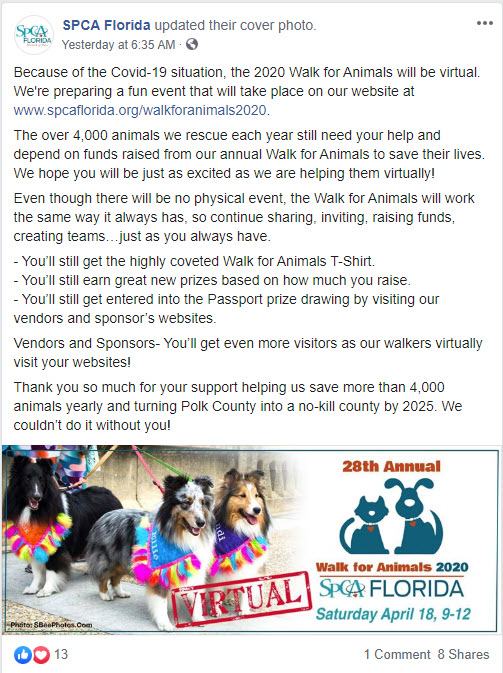Peer-to-peer events have been successfully reimagined in the wake of event cancellations caused by the coronavirus pandemic. How successfully reimagined, you ask? Well, here at Qgiv, we found that our nonprofit clients managed to raise the mean donation amount from $127.86 to $133.31 in the midst of a global pandemic, so I’d call that pretty successful!
Through thick and thin, your supporters look forward to showing up and supporting you. Rather than missing out entirely, transitioning in-person events to virtual fundraisers helps you to continue to raise crucial funds for your cause, while our supporters stay safe and support you from their own homes.
Ready to take your virtual fundraising to the next level? Here are our tips for hosting a virtual peer-to-peer event:
Tip 1: Make venue options clear to your peer-to-peer fundraising participants
If you had a physical event planned that you’re now transitioning to a virtual peer-to-peer event, your first step should be to communicate with your event participants and let them know about the venue change. Planning a hybrid event with both in-person and virtual options? Use custom fields so participants can indicate their attendance preference, and then use your CRM integration to segment your lists to make sure your participants receive follow-up emails tailored to their selection!
Just make sure your language emphasizes the safety and wellbeing of attendees in a positive way. People are exhausted after so many months of being extra careful, so making your guests feel safe and comfortable is important!
If you’re planning to transition an annual fan favorite event to a new virtual fan favorite, communicate that ahead of time so supporters have something to look forward to—especially since it means they’ll still be able to participate in your event when many entertaining activities are still being outright cancelled. Even better? Create a unique spin on the virtual version of your event to give supporters something unique to look forward to!
Give them instructions on how to get connected and participate in this new format. If you’ve created a Facebook group and/or set up a streaming service event participants can watch activities unfold from, send them that information.
Tip 2: Make activities accessible from anywhere
Events like 5K races already have virtual versions you can emulate, but what about unique event concepts that typically rely on people being present in person? It’s important to determine how to still give participants access to the activities at your event. A convenient way to engage with your participants is to ask them to watch a livestream and comment/like the content.
Facebook Live is a great solution for this. You record a video in real-time and your event participants can send comments, hearts, and likes in response. Want to dial up the participation on your live videos? Ask questions and for supporters to share their opinions. When you’re done livestreaming on Facebook, your video will still be available to view for those who missed your live broadcast.
You can use Facebook Live (or other streaming services like Twitch) to showcase different activities. Ask your participants and entertainers to livestream performances or speeches for your spectators. As you reach fundraising milestones, perform skits or livestream thank-you messages. Livestreaming is essential if you’re asking attendees to vote to determine a winner.
Accessing fitness events virtually
In cases where your participants are supposed to run a 5K or complete a physical activity like a walk-a-thon, use free fitness tracking apps like Strava, or step counter apps like Fitbit or Apple Health. Strava is perfect for measuring the distance a participant travels in cases like a 5K or marathon. They can embed the app on their personal fundraising page to show their progress. This makes each virtual participant’s progress transparent to see. Fitbit and Apple Health both are great for tracking steps and other movement data. Instead of measuring laps completed for a walk-a-thon, participants can collect donations on every hundred steps walked. If you’re measuring and sharing progress via apps for virtual fitness events, be sure to help participants get their accounts set up and on display for the event. Be prepared to help troubleshoot if needed during the event as well.
Accessible virtual event ideas
If you’re creating a new event to host virtually, think of a concept that lends itself to online-only participation. Think of television shows offering audience participation. Programs like American Idol or Who Wants to Be a Millionaire? offered audience participation opportunities that didn’t rely on attending in person. Your new event could be a talent competition and your supporters could vote by sending a text message to a specific performer’s keyword (and donate to cast their vote, of course!). If conducting a quiz show in a format like Who Wants to Be a Millionaire? incorporate an “ask the audience” option and ask viewers to comment on a livestream with their answers. The person in the hot seat can view the answers and make up their mind based on the audience’s responses.
Want to quiz your audience and award prizes to the top performers? You can create a fun, fast-paced quiz for free using Kahoot and send out the Kahoot link to your participants. Then, livestream the quiz game while participants answer questions via their cell phones. Kahoot rewards points based on correct answers, speed of answering, and correct answer streaks. Because Kahoot moves quickly, it may be helpful to create several quizzes on different subjects with multiple awards or average the points of participants at the end of all quizzes to determine top overall performers.
Tip 3: Prioritize online giving and text fundraising
To make your virtual event an effective fundraiser, your supporters need ways to give. Setting up a Facebook fundraiser for your event is low-hanging fruit and makes it easy to capture general event donations. However, if your teams are fundraising or you want livestream viewers to give in support of performers or special activities, you need specific giving forms to track what made people give. Creating unique online donation forms for different virtual events, acts, or funds is easy. For example, check out this great virtual events page from Junior Achievement of Northern California. Your peer-to-peer fundraisers can also link to their team fundraising pages on their own social media channels. If they perform, share their donation link during their performance.

If viewers are supposed to vote with their donations, it may be beneficial to set up unique text fundraising keywords for each performance. This way, supporters donate to the performances they like best. They can text the team’s keyword and be sent back a link to their specific donation form. This makes determining the top performer (at least in terms of fundraising) very easy.
Need peer-to-peer or text fundraising tools to pull off your virtual peer-to-peer event? We’ve got you covered!
Tip 4: Incorporate a digital supply drive
Is your nonprofit in need of supplies? Do your peer-to-peer events normally incorporate a supply drive to collect much-needed equipment to support the work you do? Your supporters may still be able to get you everything you need. Instead of collecting items during a large, crowded event, ask participants to donate to your supply drive by purchasing items from an online wish list.
Online shopping makes for a great alternative to a typical supply drive. Websites like Amazon.com make it easy to create wish lists and share those lists with others. Be sure you include the quantities of items you need so that once one item is purchased the item isn’t removed from your list. Think about your normal rate of consumption and ask for what you need in those quantities.
Bonus Tip: If you set up a wish list with Amazon, ask donors to support you by making their purchases with Amazon Smile. Amazon Smile is a service that pays a portion of the purchase price to your nonprofit when shoppers buy from your unique Amazon Smile link. Set up Amazon Smile, create your wish list, and link to the Amazon site in social posts and on your blog using your Amazon Smile link. Your supporters get the same Amazon website experience and won’t be charged extra for purchasing from this special link. You’ll benefit from their purchases by receiving a donation check from Amazon in addition to receiving the items you need.
Conclusion
Rather than cancelling or postponing your peer-to-peer events until the pandemic is officially over, transition to virtual events that give both safety and added convenience to your supporters. Not all events can be virtual, but it’s surprising how many can work as an online-only event. Hopefully the above tips make it easy for you to transition an existing event into a virtual peer-to-peer event or help you create your first virtual fundraiser.
Check out these additional resources to help make your next virtual fundraising a rollicking success!
- Need advice for hosting a virtual silent auction? Here for Four Tips to Turn a Silent Auction into a Virtual Party.
- Ready to plan your next virtual fundraiser? Make planning a snap with the FREE virtual event planner!
- Interested in Qgiv’s fundraising platform? Request a demo to see our tools in action!








